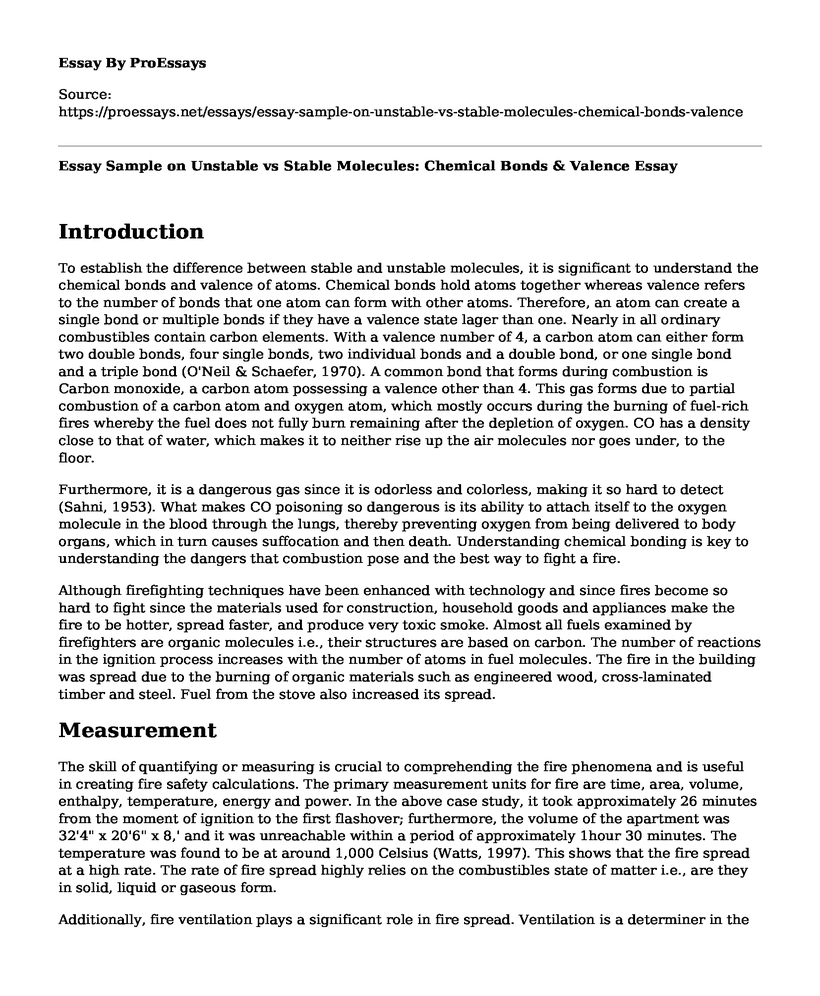Introduction
To establish the difference between stable and unstable molecules, it is significant to understand the chemical bonds and valence of atoms. Chemical bonds hold atoms together whereas valence refers to the number of bonds that one atom can form with other atoms. Therefore, an atom can create a single bond or multiple bonds if they have a valence state lager than one. Nearly in all ordinary combustibles contain carbon elements. With a valence number of 4, a carbon atom can either form two double bonds, four single bonds, two individual bonds and a double bond, or one single bond and a triple bond (O'Neil & Schaefer, 1970). A common bond that forms during combustion is Carbon monoxide, a carbon atom possessing a valence other than 4. This gas forms due to partial combustion of a carbon atom and oxygen atom, which mostly occurs during the burning of fuel-rich fires whereby the fuel does not fully burn remaining after the depletion of oxygen. CO has a density close to that of water, which makes it to neither rise up the air molecules nor goes under, to the floor.
Furthermore, it is a dangerous gas since it is odorless and colorless, making it so hard to detect (Sahni, 1953). What makes CO poisoning so dangerous is its ability to attach itself to the oxygen molecule in the blood through the lungs, thereby preventing oxygen from being delivered to body organs, which in turn causes suffocation and then death. Understanding chemical bonding is key to understanding the dangers that combustion pose and the best way to fight a fire.
Although firefighting techniques have been enhanced with technology and since fires become so hard to fight since the materials used for construction, household goods and appliances make the fire to be hotter, spread faster, and produce very toxic smoke. Almost all fuels examined by firefighters are organic molecules i.e., their structures are based on carbon. The number of reactions in the ignition process increases with the number of atoms in fuel molecules. The fire in the building was spread due to the burning of organic materials such as engineered wood, cross-laminated timber and steel. Fuel from the stove also increased its spread.
Measurement
The skill of quantifying or measuring is crucial to comprehending the fire phenomena and is useful in creating fire safety calculations. The primary measurement units for fire are time, area, volume, enthalpy, temperature, energy and power. In the above case study, it took approximately 26 minutes from the moment of ignition to the first flashover; furthermore, the volume of the apartment was 32'4" x 20'6" x 8,' and it was unreachable within a period of approximately 1hour 30 minutes. The temperature was found to be at around 1,000 Celsius (Watts, 1997). This shows that the fire spread at a high rate. The rate of fire spread highly relies on the combustibles state of matter i.e., are they in solid, liquid or gaseous form.
Additionally, fire ventilation plays a significant role in fire spread. Ventilation is a determiner in the attainment of flashover. If the fire is exposed to more air, it spreads much faster due to its exposure to oxygen. In the building, upon failing, the gypsum plasterboards allowed heated gases and fire to travel throughout the apartment buildings on the second and third floors.
References
O'Neil, S. V., & Schaefer III, H. F. (1970). ValenceExcited States of Carbon Monoxide. The Journal of Chemical Physics, 53(10), 3994-4004. Retrieved from: https://aip.scitation.org/doi/abs/10.1063/1.1673871
Sahni, R. C. (1953). The structure of carbon monoxide. Transactions of the Faraday Society, 49, 1246-1253.
Watts, J. M. (1997). Fire risk assessment using multiattribute evaluation. Fire Safety Science, 5, 679-690. Retrieved from: http://www.iafss.org/publications/fss/5/679
Cite this page
Essay Sample on Unstable vs Stable Molecules: Chemical Bonds & Valence. (2023, Mar 14). Retrieved from https://proessays.net/essays/essay-sample-on-unstable-vs-stable-molecules-chemical-bonds-valence
If you are the original author of this essay and no longer wish to have it published on the ProEssays website, please click below to request its removal:
- Some Questions on Physics
- Essay Example on Somalia, Its Government, Civil Society and Economic Environment
- Essay Sample on Space Laws and Ethics
- Paper Example on Water of Crystallization
- Electron Orbitals Essay Example
- Assignment Example on Energy Strength of the Bond
- Essay Example on 5 Top Nootropics: Caffeine, Creatine, Bacopa, L-Theanine, Rhodiola







